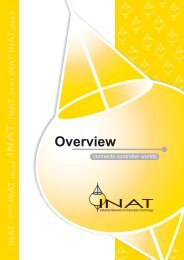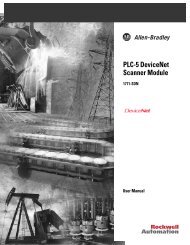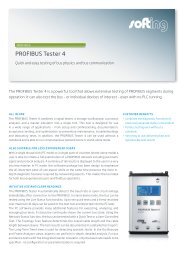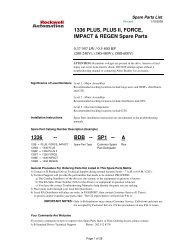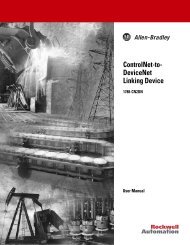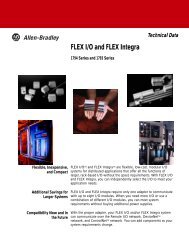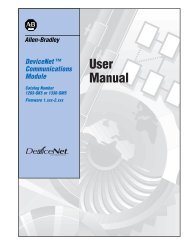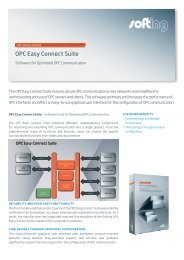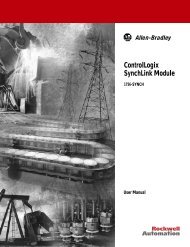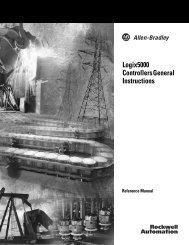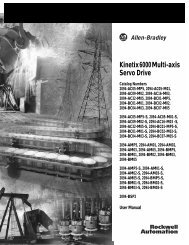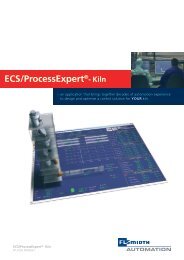1756-IN058D-EN-P, ControlLogix Installation Instructions
1756-IN058D-EN-P, ControlLogix Installation Instructions
1756-IN058D-EN-P, ControlLogix Installation Instructions
You also want an ePaper? Increase the reach of your titles
YUMPU automatically turns print PDFs into web optimized ePapers that Google loves.
<strong>Installation</strong> <strong>Instructions</strong><br />
<strong>ControlLogix</strong><br />
DC (19.2-30V) Diagnostic Output Module<br />
(Catalog Number <strong>1756</strong>-OB16D)<br />
To:<br />
See page:<br />
Obtain a User Manual 1<br />
Identify the Module Components 2<br />
Prevent Electrostatic Discharge 3<br />
See Removal and Insertion Under Power (RIUP) 3<br />
Understand Compliance to European Union Directive 4<br />
Note the Power Requirements 5<br />
Install the Module 5<br />
Key the Removable Terminal Block/Interface Module 6<br />
Wire the Module 7<br />
Assemble the Removable Terminal Block and the Housing 8<br />
Install the Removable Terminal Block onto the Module 8<br />
Check the Indicators 10<br />
Remove the Removable Terminal Block from the Module 11<br />
Remove the Module 12<br />
See <strong>1756</strong>-OB16D Specifications 12<br />
Hazardous Location information 14<br />
Obtain a User Manual<br />
This product also has a user manual (pub. no. <strong>1756</strong>-6.5.8). To view it,<br />
visit www.ab.com/manuals or www.theautomationbookstore.com<br />
You can also purchase a printed manual by:<br />
• contacting your local distributor or Rockwell Automation<br />
representative<br />
• visiting www.theautomationbookstore.com and placing<br />
an order<br />
Publication <strong>1756</strong>-<strong>IN058D</strong>-<strong>EN</strong>-P - October 2000
2 <strong>ControlLogix</strong> DC (19.2-30V) Diagnostic Output Module<br />
• calling 800.963.9548 (USA/Canada) or 001.320.725.1574<br />
(outside USA/Canada)<br />
Identify the Module Components<br />
You received the following components with your order:<br />
• <strong>1756</strong>-OB16D module<br />
• Removable Terminal Block (RTB) door label<br />
If you did not receive these components, contact your Rockwell<br />
Automation sales office.<br />
This module mounts in a <strong>ControlLogix</strong> chassis and uses a<br />
separately-ordered RTB or a Bulletin 1492 Interface Module (IFM) to<br />
connect all field-side wiring.<br />
This module uses one of the following RTBs:<br />
• <strong>1756</strong>-TBCH 36 position Cage clamp RTB<br />
• <strong>1756</strong>-TBS6H 36 position Spring clamp RTB<br />
Use an extended-depth cover (<strong>1756</strong>-TBE) for applications with heavy<br />
gauge wiring or requiring additional routing space. When using an<br />
IFM, consult the documentation that came with it to connect<br />
all wiring.<br />
IMPORTANT<br />
Before you install your module, you should<br />
have already:<br />
• installed and grounded a <strong>1756</strong> chassis and<br />
power supply.<br />
• ordered and received an RTB or IFM and its<br />
components for your application.<br />
Publication <strong>1756</strong>-<strong>IN058D</strong>-<strong>EN</strong>-P - October 2000
Prevent Electrostatic Discharge<br />
<strong>ControlLogix</strong> DC (19.2-30V) Diagnostic Output Module 3<br />
ATT<strong>EN</strong>TION<br />
!<br />
Electrostatic discharge can damage integrated circuits or<br />
semiconductors if you touch backplane connector pins.<br />
Follow these guidelines when you handle the module:<br />
• Touch a grounded object to discharge<br />
static potential.<br />
• Wear an approved wrist-strap grounding device.<br />
• Do not touch the backplane connector or connector<br />
pins.<br />
• Do not touch circuit components inside the module.<br />
• If available, use a static-safe work station.<br />
• When not in use, keep the module in its static-shield<br />
box.<br />
Removal and Insertion Under Power (RIUP)<br />
WARNING<br />
!<br />
This module is designed so you can remove and insert it<br />
under backplane power and field-side power. When you<br />
remove or insert a module while field-side power is<br />
applied, you may cause an electrical arc. An electrical<br />
arc can cause personal injury or property damage<br />
because it may:<br />
• send an erroneous signal to your system’s field<br />
devices, causing unintended machine motion or loss<br />
of process control.<br />
• cause an explosion in a hazardous environment.<br />
Repeated electrical arcing causes excessive wear to<br />
contacts on both the module and its mating connector.<br />
Worn contacts may create electrical resistance.<br />
When you insert or remove the module while backplane<br />
power is on, or you connect or disconnect the RTB with<br />
field-side power applied, an electrical arc can occur. This<br />
could cause an explosion in hazardous location<br />
installations. Be sure that power is removed or the area is<br />
non-hazardous before proceeding.<br />
Publication <strong>1756</strong>-<strong>IN058D</strong>-<strong>EN</strong>-P - October 2000
4 <strong>ControlLogix</strong> DC (19.2-30V) Diagnostic Output Module<br />
Understand Compliance to European Union Directive<br />
If this product bears the CE marking, it is approved for installation<br />
within the European Union and EEA regions. It has been designed<br />
and tested to meet the following directives.<br />
EMC Directive<br />
This product is tested to meet Council Directive 89/336/EEC<br />
Electromagnetic Compatibility (EMC) and the following standards, in<br />
whole or in part, documented in a technical construction file:<br />
• <strong>EN</strong> 50081-2 EMC - Generic Emission Standard, Part 2 -<br />
Industrial Environment<br />
• <strong>EN</strong> 50082-2 EMC - Generic Immunity Standard, Part 2 -<br />
Industrial Environment<br />
This product is intended for use in an industrial environment.<br />
Low Voltage Directive<br />
This product is tested to meet Council Directive 73/23/EEC Low<br />
Voltage, by applying the safety requirements of <strong>EN</strong> 61131-2<br />
Programmable Controllers, Part 2 - Equipment Requirements and<br />
Tests.<br />
For specific information required by <strong>EN</strong> 61131-2, see the appropriate<br />
sections in this publication, as well as the following Allen-Bradley<br />
publications:<br />
• Industrial Automation Wiring and Grounding Guidelines,<br />
publication 1770-4.1<br />
• Automation Systems Catalog, publication B111<br />
This equipment is classified as open equipment and must be installed<br />
(mounted) in an enclosure during operation as a means of providing<br />
safety protection.<br />
Publication <strong>1756</strong>-<strong>IN058D</strong>-<strong>EN</strong>-P - October 2000
Note the Power Requirements<br />
<strong>ControlLogix</strong> DC (19.2-30V) Diagnostic Output Module 5<br />
This module receives power from the <strong>1756</strong> chasis power supply and<br />
requires 2 sources of power from the backplane:<br />
• 250mA at 5.1V dc<br />
• 140mA at 24V dc<br />
Add this current/power value (4.64W) to the requirements of all other<br />
modules in the chassis to prevent overloading the power supply.<br />
Install the Module<br />
You can install or remove the module while chassis power is applied.<br />
ATT<strong>EN</strong>TION<br />
!<br />
The module is designed to support Removal and<br />
Insertion Under Power (RIUP). However, when<br />
you remove or insert an RTB with field-side power<br />
applied, unintended machine motion or loss of<br />
process control can occur. Exercise extreme<br />
caution when using this feature.<br />
1. Align circuit board with top and<br />
bottom chassis guides.<br />
2. Slide module into chassis until<br />
module locking tabs ‘click’.<br />
Locking tab<br />
Printed<br />
Circuit<br />
Board<br />
20861–M 20862–M<br />
Publication <strong>1756</strong>-<strong>IN058D</strong>-<strong>EN</strong>-P - October 2000
6 <strong>ControlLogix</strong> DC (19.2-30V) Diagnostic Output Module<br />
Key the Removable Terminal Block/Interface Module<br />
Wedge-shaped keying tabs and U-shaped keying bands came with<br />
your RTB to prevent connecting the wrong wires to your module.<br />
Key positions on the module that correspond to unkeyed positions<br />
on the RTB. For example, if you key the first position on the module,<br />
leave the first position on the RTB unkeyed.<br />
Key the Module<br />
1. Insert the U-shaped band as shown.<br />
2. Push the band until it snaps in place.<br />
Key the RTB/IFM<br />
1. Insert the wedge-shaped tab with rounded edge first.<br />
2. Push the tab until it stops.<br />
Wedge-shaped tab<br />
U-shaped<br />
bands<br />
20850–M<br />
Reposition the tabs to rekey future module applications.<br />
20851–M<br />
Wire the Removable Terminal Block<br />
Wire the RTB with a 1/8 inch (3.2mm) maximum flat-bladed<br />
screwdriver before installing it onto the module.<br />
Spring Clamp RTB<br />
1. Strip 7/16 inch (11mm) maximum length of<br />
wire.<br />
2. Insert the screwdriver into the inner hole<br />
of the RTB.<br />
Cage Clamp RTB<br />
1. Strip 3/8 inch (9.5mm) maximum length of<br />
wire.<br />
2. Insert the wire into the open terminal.<br />
3. Turn the screw clockwise to close the<br />
terminal on the wire.<br />
3. Insert the wire into the open<br />
terminal and remove the<br />
screwdriver.<br />
20860-M 20859-M<br />
Publication <strong>1756</strong>-<strong>IN058D</strong>-<strong>EN</strong>-P - October 2000
Wire the Module<br />
<strong>ControlLogix</strong> DC (19.2-30V) Diagnostic Output Module 7<br />
You can only connect wiring to your module through an RTB or IFM.<br />
The example below shows how to wire the module.<br />
Daisy chain to other RTBs<br />
<strong>1756</strong>-OB16D<br />
+DC-0<br />
2 1 OUT-0<br />
+DC-0<br />
4 3 OUT-1<br />
+DC-0<br />
6 5 OUT-2<br />
+DC-0<br />
8 7 OUT-3<br />
Group 0<br />
+DC-0<br />
10 9 OUT-4<br />
+DC-0<br />
12 11 OUT-5<br />
Group 0<br />
+DC-0<br />
14 13 OUT-6<br />
GND-0<br />
16 15 OUT-7<br />
+DC-1<br />
18 17 OUT-8<br />
+DC-1<br />
20 19 OUT-9<br />
+DC-1<br />
22 21 OUT-10<br />
+DC-1<br />
24 23 OUT-11<br />
+DC-1<br />
26 25 OUT-12<br />
Group 1<br />
+DC-1<br />
28 27 OUT-13<br />
Group 1<br />
+DC-1<br />
30 29 OUT-14<br />
GND-1<br />
32 31 OUT-15<br />
GND-1<br />
34 33 Not used<br />
Not used<br />
36 35 Not used<br />
Daisy chain<br />
to other RTBs<br />
+ –<br />
DC COM<br />
1. All terminals with the same name are connected together on the module. For example,<br />
DC COM can be connected to either terminal marked GND-1.<br />
40173-M<br />
2. When you daisy chain to other RTBs, always connect the daisy chain to the terminal<br />
directly connected to the supply wire, as shown in the example above.<br />
3. This wiring example shows a single voltage source.<br />
4. If separate power sources are used, do not exceed the specified isolation voltage.<br />
After completing field-side wiring, secure the wires in the strain relief<br />
area with a cable-tie.<br />
Publication <strong>1756</strong>-<strong>IN058D</strong>-<strong>EN</strong>-P - October 2000
8 <strong>ControlLogix</strong> DC (19.2-30V) Diagnostic Output Module<br />
Assemble the Removable Terminal Block and the Housing<br />
1. Align the grooves at the bottom of the housing with the side edges of the RTB.<br />
Groove<br />
Groove<br />
Side edge of the RTB<br />
Strain relief area<br />
Side edge of the RTB<br />
2. Slide the RTB into the housing until it snaps into place. 20858–M<br />
Install the Removable Terminal Block onto the Module<br />
WARNING<br />
!<br />
The RTB is designed to support Removal and Insertion<br />
Under Power (RIUP). However, when you remove or<br />
insert an RTB with field-side power applied, unintended<br />
machine motion or loss of process control can<br />
occur. Exercise extreme caution when using this feature.<br />
It is recommended that field-side power be removed<br />
before installing the RTB onto the module.<br />
When you remove or insert a module while field-side<br />
power is applied, you may cause an electrical arc. An<br />
electrical arc can cause personal injury or property<br />
damage because it may:<br />
• send an erroneous signal to your system’s field<br />
devices, causing unintended machine motion or loss<br />
of process control.<br />
• cause an explosion in a hazardous environment.<br />
Repeated electrical arcing causes excessive wear to<br />
contacts on both the module and its mating connector.<br />
Worn contacts may create electrical resistance.<br />
When you insert or remove the module while backplane<br />
power is on, or you connect or disconnect the RTB with<br />
field-side power applied, an electrical arc can occur. This<br />
could cause an explosion in hazardous location<br />
installations. Be sure that power is removed or the area is<br />
non-hazardous before proceeding.<br />
Publication <strong>1756</strong>-<strong>IN058D</strong>-<strong>EN</strong>-P - October 2000
<strong>ControlLogix</strong> DC (19.2-30V) Diagnostic Output Module 9<br />
Before installing the RTB, make certain:<br />
• field-side wiring of the RTB has been completed.<br />
• the RTB housing is snapped into place on the RTB.<br />
• the RTB housing door is closed.<br />
• the locking tab at the top of the module is unlocked.<br />
1. Align the side and top, bottom RTB guides with the<br />
side, top and bottom module guides.<br />
Module<br />
guide<br />
RTB guides<br />
20853–M<br />
2. Press quickly and evenly to seat the RTB on the<br />
module until the latches snap into place.<br />
Locking<br />
tab<br />
3. Slide the locking tab down to lock the RTB<br />
onto the module.<br />
20854–M<br />
Publication <strong>1756</strong>-<strong>IN058D</strong>-<strong>EN</strong>-P - October 2000
10 <strong>ControlLogix</strong> DC (19.2-30V) Diagnostic Output Module<br />
Check the Indicators<br />
The indicators show individual I/O status (yellow) for each point and<br />
a bi-colored LED for module "OK" (red/green).<br />
DC OUTPUT<br />
ST012 34567<br />
FLT012 34567<br />
ST 8 9 10 11 12 13 14 15<br />
FLT 8 9 101112131415<br />
DIAGNOSTIC<br />
During power up, an indicator test is done and the following occurs:<br />
• The "OK" indicator turns red for 1 second and then turns to<br />
flashing green if it has passed the self-test.<br />
• The I/O status indicators turn ON for a maximum of 2 seconds<br />
and then turn OFF.<br />
O<br />
K<br />
40463-M<br />
LED<br />
indicator:<br />
This<br />
display:<br />
Means:<br />
Take this action:<br />
OK<br />
Steady<br />
green light<br />
The outputs are actively being<br />
controlled by a system<br />
processor.<br />
None<br />
OK<br />
Flashing<br />
green light<br />
The module has passed<br />
internal diagnostics but is not<br />
actively controlled.<br />
Configure the module.<br />
OK<br />
Flashing red<br />
light<br />
Previously established<br />
communication has timed out.<br />
Check controller and chassis<br />
communication.<br />
OK<br />
Steady red<br />
light<br />
An unrecoverable error has<br />
occurred on the module.<br />
Replace the module.<br />
I/O State Yellow The output is active. None<br />
I/O Fault Red A fault has occurred for this<br />
point.<br />
Check this point at the<br />
controller.<br />
This completes installation of the module. Use the information below<br />
to remove the module.<br />
Publication <strong>1756</strong>-<strong>IN058D</strong>-<strong>EN</strong>-P - October 2000
<strong>ControlLogix</strong> DC (19.2-30V) Diagnostic Output Module 11<br />
Remove the Removable Terminal Block from the Module<br />
WARNING<br />
!<br />
Shock hazard exists. If the RTB is removed from<br />
the module while the field-side power is applied,<br />
the module will be electrically live. Do not touch<br />
the RTB’s terminals. Failure to observe this caution<br />
may cause personal injury.<br />
The RTB is designed to support Removal and<br />
Insertion Under Power (RIUP). However, when<br />
you remove or insert an RTB with field-side power<br />
applied, unintended machine motion or loss of<br />
process control can occur. Exercise extreme<br />
caution when using this feature. It is<br />
recommended that field-side power be removed<br />
before removing the module.<br />
When you insert or remove the module while<br />
backplane power is on, or you connect or<br />
disconnect the RTB with field-side power applied,<br />
an electrical arc can occur. This could cause an<br />
explosion in hazardous location installations. Be<br />
sure that power is removed or the area is<br />
non-hazardous before proceeding.<br />
Before removing the module, you must remove the RTB.<br />
1. Unlock the locking tab at the<br />
top of the module.<br />
2. Open the RTB door and pull the<br />
RTB off the module.<br />
42517<br />
20855–M<br />
Publication <strong>1756</strong>-<strong>IN058D</strong>-<strong>EN</strong>-P - October 2000
12 <strong>ControlLogix</strong> DC (19.2-30V) Diagnostic Output Module<br />
Remove the Module<br />
1. Push in top and bottom locking tabs. 2. Pull module out of the chassis.<br />
20856–M 20857–M<br />
<strong>1756</strong>-OB16D Specifications<br />
Number of Outputs<br />
Module Location<br />
Backplane Current<br />
Max. Power Dissipation (Module)<br />
Thermal Dissipation<br />
Output Voltage Range<br />
Output Current Rating<br />
Per Point<br />
Per Module<br />
Surge Current per Point<br />
Minimum Load Current<br />
Maximum On-State Voltage Drop<br />
Max. Off-State Leakage Current<br />
Output Delay Time<br />
OFF to ON<br />
ON to OFF<br />
Diagnostic Functions:<br />
Short trip<br />
No load<br />
Output verification<br />
Pulse test<br />
Time stamp of diagnostics<br />
Configurable Fault States/Point<br />
Configurable States in Program<br />
Mode/Point<br />
16 (8 points/common)<br />
<strong>1756</strong> <strong>ControlLogix</strong> Chassis<br />
250mA @ 5.1V dc & 140mA @ 24V dc<br />
(Total backplane power 4.64W)<br />
3.3W @ 60 o C<br />
11.25 BTU/hr<br />
19.2-30V dc<br />
2A max. @ 30°C & 1A max. @ 60°C (Linear derating)<br />
8A max. @ 30°C & 4A max. @ 60°C (Linear derating)<br />
4A for 10ms each, repeatable every 1s<br />
3mA per point<br />
1.2V dc @ 2A<br />
1mA per point<br />
1ms maximum<br />
5ms maximum<br />
8A 180ms minimum<br />
10A 120ms minimum<br />
OFF STATE detection only<br />
ON STATE detection only<br />
User selectable maximum pulse width<br />
+/- 1ms<br />
Hold Last State, ON or OFF (OFF is the default)<br />
Hold Last State, ON or OFF (OFF is the default)<br />
Publication <strong>1756</strong>-<strong>IN058D</strong>-<strong>EN</strong>-P - October 2000
<strong>ControlLogix</strong> DC (19.2-30V) Diagnostic Output Module 13<br />
Scheduled Outputs<br />
Fusing<br />
Reverse Polarity Protection<br />
Isolation Voltage<br />
Group to group<br />
Synchronization within 16.7s maximum, reference to<br />
the Coordinated System Time<br />
Electronically fused per point<br />
None - If module is wired incorrectly, outputs may be<br />
damaged.<br />
100% tested at 2546V dc for 1s<br />
(250V ac max. continuous voltage between groups)<br />
User to system<br />
100% tested at 2546V dc for 1s<br />
RTB Screw Torque (Cage clamp) 4.4 inch-pounds (0.4Nm) maximum<br />
Module Keying (Backplane) Software configurable<br />
RTB Keying<br />
User defined mechanical keying<br />
RTB and Housing 36 Position RTB (<strong>1756</strong>-TBCH or TBS6H) 1<br />
Environmental Conditions<br />
Operating Temperature<br />
Storage Temperature<br />
Relative Humidity<br />
Conductors Wire Size<br />
Category<br />
Screwdriver Blade Width for RTB<br />
Agency Certification<br />
(when product or<br />
packaging is marked)<br />
0 to 60°C (32 to 140°F)<br />
-40 to 85°C (-40 to 185°F)<br />
5 to 95% noncondensing<br />
22-14-gauge (2mm 2 ) stranded 1<br />
3/64 inch (1.2mm) insulation maximum<br />
1 2, 3<br />
1/8 inch (3.2mm) maximum<br />
N223<br />
Listed Industrial Control Equipment<br />
Certified Process Control Equipment<br />
Certified Class I, Division 2, Group A, B, C, D<br />
Approved Class I, Division 2, Group A, B, C, D<br />
Marked for all applicable directives<br />
Marked for all applicable acts<br />
1 Maximum wire size will require extended housing - <strong>1756</strong>-TBE.<br />
2 Use this conductor category information for planning conductor routing as described in the system<br />
level installation manual.<br />
3 Refer to publication 1770-4.1 “Industrial Automation Wiring and Grounding Guidelines’.<br />
Additional Notes<br />
The <strong>ControlLogix</strong> system must be mounted within a suitable enclosure to<br />
prevent personal injury resulting from accessibility to live parts. The interior of<br />
this enclosure must be accessible only by the use of a tool.<br />
Publication <strong>1756</strong>-<strong>IN058D</strong>-<strong>EN</strong>-P - October 2000
14 <strong>ControlLogix</strong> DC (19.2-30V) Diagnostic Output Module<br />
This industrial control equipment is intended to operate in a Pollution Degree<br />
2 environment, in overvoltage category II applications, as defined in IEC<br />
publication 664A, at altitudes up to 2000 meters without derating.<br />
Hazardous Location information<br />
The following information applies when operating this equipment in<br />
hazardous locations:<br />
Products marked “CL I, DIV 2, GP A, B, C, D” are suitable for use in<br />
Class I Division 2 Groups A, B, C, D, Hazardous Locations and<br />
nonhazardous locations only. Each product is supplied with markings<br />
on the rating nameplate indicating the hazardous location<br />
temperature code. When combining products within a system, the<br />
most adverse temperature code (lowest “T” number) may be used to<br />
help determine the overall temperature code of the system.<br />
Combinations of equipment in your system are subject to<br />
investigation by the local Authority Having Jurisdiction at the time<br />
of installation.<br />
WARNING<br />
!<br />
EXPLOSION HAZARD<br />
• Do not disconnect equipment unless power has<br />
been removed or the area is known to be<br />
nonhazardous.<br />
• Do not disconnect connections to this equipment<br />
unless power has been removed or the area is<br />
known to be nonhazardous. Secure any external<br />
connections that mate to this equipment by using<br />
screws, sliding latches, threaded connectors, or<br />
other means provided with this product.<br />
• Substitution of components may impair suitability<br />
for Class I, Division 2.<br />
• If this product contains batteries, they must only be<br />
changed in an area known to be nonhazardous.<br />
Publication <strong>1756</strong>-<strong>IN058D</strong>-<strong>EN</strong>-P - October 2000
<strong>ControlLogix</strong> DC (19.2-30V) Diagnostic Output Module 15<br />
Informations sur l’utilisation de cet équipement en environnements<br />
dangereux :<br />
Les produits marqués « CL I, DIV 2, GP A, B, C, D » ne conviennent<br />
qu’à une utilisation en environnements de Classe I Division 2<br />
Groupes A, B, C, D dangereux et non dangereux. Chaque produit est<br />
livré avec des marquages sur sa plaque d’identification qui indiquent<br />
le code de température pour les environnements dangereux. Lorsque<br />
plusieurs produits sont combinés dans un système, le code de<br />
température le plus défavorable (code de température le plus faible)<br />
peut être utilisé pour déterminer le code de température global du<br />
système. Les combinaisons d’équipements dans le système sont<br />
sujettes à inspection par les autorités locales qualifiées au moment de<br />
l’installation.<br />
AVERTISSEM<strong>EN</strong>T<br />
!<br />
RISQUE D’EXPLOSION<br />
• Couper le courant ou s’assurer que l’environnement<br />
est classé non dangereux avant de débrancher<br />
l’équipement.<br />
• Couper le courant ou s’assurer que l’environnement<br />
est classé non dangereux avant de débrancher les<br />
connecteurs. Fixer tous les connecteurs externes<br />
reliés à cet équipement à l’aide de vis, loquets<br />
coulissants, connecteurs filetés ou autres moyens<br />
fournis avec ce produit.<br />
• La substitution de composants peut rendre cet<br />
équipement inadapté à une utilisation en<br />
environnement de Classe 1, Division 2.<br />
• S’assurer que l’environnement est classé non<br />
dangereux avant de changer les piles.<br />
Publication <strong>1756</strong>-<strong>IN058D</strong>-<strong>EN</strong>-P - October 2000
Publication <strong>1756</strong>-<strong>IN058D</strong>-<strong>EN</strong>-P - October 2000 PN 957424-02<br />
Supersedes Publication <strong>1756</strong>-5.8 - September 1999<br />
© 2000 Rockwell International Corporation. Printed in USA




